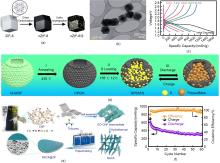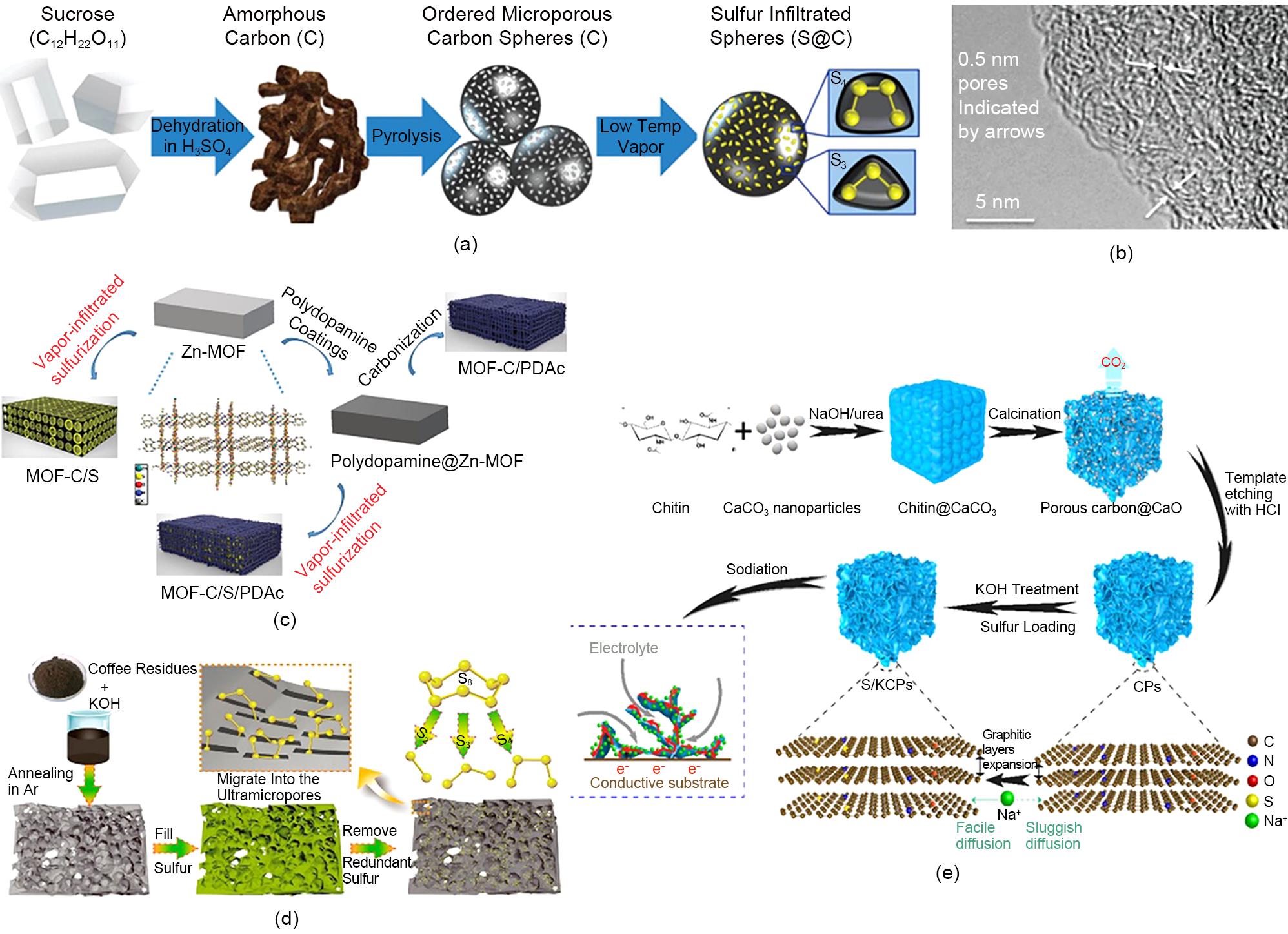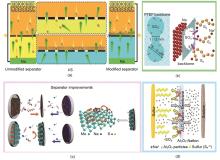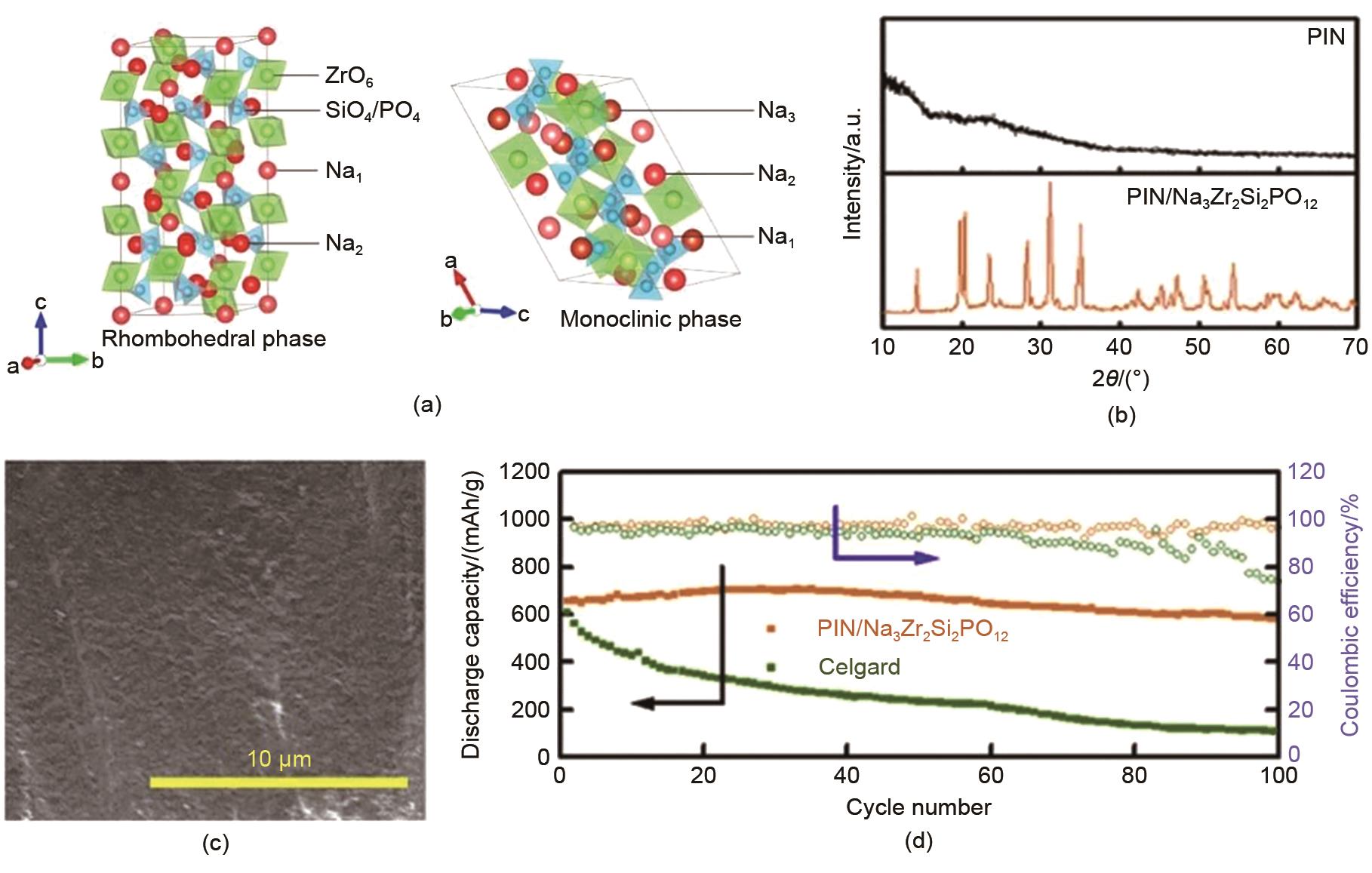Energy Storage Science and Technology ›› 2023, Vol. 12 ›› Issue (5): 1315-1331.doi: 10.19799/j.cnki.2095-4239.2023.0255
• Special Issue on Key Materials and Recycling Technologies for Energy Storage Batteries • Previous Articles Next Articles
Shedong LI1( ), Yingying SONG2, Yuhua BIAN1, Zhaomeng LIU1, Xuanwen GAO1(
), Yingying SONG2, Yuhua BIAN1, Zhaomeng LIU1, Xuanwen GAO1( ), Wenbin LUO1
), Wenbin LUO1
Received:2023-04-21
Revised:2023-04-25
Online:2023-05-05
Published:2023-05-29
Contact:
Xuanwen GAO
E-mail:2201617@stu.neu.edu.cn;gaoxuanwen@mail.neu.edu.cn
CLC Number:
Shedong LI, Yingying SONG, Yuhua BIAN, Zhaomeng LIU, Xuanwen GAO, Wenbin LUO. Status and challenges in the development of room-temperature sodium-sulfur batteries[J]. Energy Storage Science and Technology, 2023, 12(5): 1315-1331.

Fig. 4
(a) Preparation process of the cZIF-8/S composite, (b) TEM image of the individual cZIF-8 particles, (c) Discharge pro?le at different rate[35], (d) The synthesis process of the HPCM/S composite, (e) Schematic illustrations of the preparation process of NSCA, (f) Cycling performance and Coulombic efficiency s of HPCM/S composite electrode at 0.7 C"


Fig. 5
(a) Schematic synthesis process of the materials steps using sucrose, (b) Transmission electron microscope (TEM) image exhibiting the morphology of micropores inside carbon spheres[37], (c) Fabrication process and schematics of structures of Zn-MOF, MOF-C/S, MOF-C/PDAc, and MOF-C/S/PDAc composites, (d) Schematic illustration of preparation process of the microporous carbon a with small S molecules[39] (e) Graphical Illustration of the Preparation of S/KCPs"


Fig. 6
(a) Binding energies of sodium sul?de, short-chain sodium polysul?des, and sulfur allotropes to various nitrogen-containing groups within a carbon framework, (b) Cycle performance of the MPC 800-S composite cathode at 0.5 C[56], (c) The typical TEM images of covalent S-C, (d) Diagram of the covalent S-C reaction mechanism, (e) Rate performance[54]"


Fig. 7
(a) Schematic diagram of the modi?ed separator to inhibit polysul?de shuttle effect in Na-S batteries[61], (b) Architecture of Nafion membrane and schematic illustration of the ionic-selectivity of the Nafion membrane by ionic interactions at the hydrophilic pores of the membrane[65], (c) Schematic diagram of the S/C composite and the S@HCS/MoS2 electrode with modified glass fiber during the discharge process[66], (d) Schematic illustration of the Al2O3-Nafion separator blocking polysulfide shuttling[67]"


Fig. 10
(a) Crystal structures of the representative NASICON (Na3Zr2Si2PO12) with rhombohedral and monoclinic phase[81], (b) XRD pattern of the PIN material and a PIN-coated Na3Zr2Si2PO12 pellet, (c) SEM image of the surface of a PIN-coated Na3Zr2Si2PO12 pellet, (d) Specific discharge capacities and Coulombic ef?ciencies versus cycling number of a Na ∥ PIN-Na3Zr2Si2PO12 ∥ CNF/S cell and a Na ∥ Celgard ∥ CNF/S cell at a cycling rate of C/5[61]"

| 1 | ONIFADE S T. Environmental impacts of energy indicators on ecological footprints of oil-exporting african countries: Perspectives on fossil resources abundance amidst sustainable development quests[J]. Resources Policy, 2023, 82: 103481. |
| 2 | LIANG Y R, ZHAO C Z, YUAN H, et al. A review of rechargeable batteries for portable electronic devices[J]. InfoMat, 2019, 1(1): 6-32. |
| 3 | 缪平, 姚祯, LEMMON John, 等. 电池储能技术研究进展及展望[J]. 储能科学与技术, 2020, 9(3): 670-678. |
| MIAO P, YAO Z, LEMMON JOHN, et al. Current situations and prospects of energy storage batteries[J]. Energy Storage Science and Technology, 2020, 9(3): 670-678. | |
| 4 | ZHU Q, XU H F, SHEN K, et al. Efficient polysulfides conversion on Mo2CT_x MXene for high-performance lithium-sulfur batteries[J].Rare Metals, 2022, 41(1): 311-318. |
| 5 | LIU Z M, WANG J, LU B G. Plum pudding model inspired KVPO4F@3DC as high-voltage and hyperstable cathode for potassium ion batteries[J]. Science Bulletin, 2020, 65(15): 1242-1251. |
| 6 | LEI Y J, WU C, LU X X, et al. Streamline sulfur redox reactions to achieve efficient room-temperature sodium-sulfur batteries[J]. Angewandte Chemie International Edition, 2022, 61(16):doi: 10.1002/anie.202200384. |
| 7 | MU J J, LIU Z M, LAI Q S, et al. An industrial pathway to emerging presodiation strategies for increasing the reversible ions in sodium-ion batteries and capacitors[J]. Energy Materials, 2022, 2(6): 200043. |
| 8 | WANG J, LIU Z M, ZHOU J, et al. Insights into metal/metalloid-based alloying anodes for potassium ion batteries[J]. ACS Materials Letters, 2021, 3(11): 1572-1598. |
| 9 | WANG C L, ZHANG Y, ZHANG Y W, et al. Stable sodium-sulfur electrochemistry enabled by phosphorus-based complexation[J]. Proceedings of the National Academy of Sciences of the United States of America, 2021, 118(49): https://doi.org/10.1073/pnas.2116184118. |
| 10 | WANG L F, WANG H Y, ZHANG S P, et al. Manipulating the electronic structure of nickel via alloying with iron: Toward high-kinetics sulfur cathode for Na-S batteries[J]. ACS Nano, 2021, 15(9): 15218-15228. |
| 11 | LIU Z M, WANG J, DING H B, et al. Carbon nanoscrolls for aluminum battery[J]. ACS Nano, 2018, 12(8): 8456-8466. |
| 12 | WANG Y, HUANG XIANG LONG, LIU H W, et al. Nanostructure engineering strategies of cathode materials for room-temperature Na-S batteries[J]. ACS Nano, 2022, 16(4): 5103-5130. |
| 13 | DU W Y, GAO W, YANG T T, et al. Cobalt nanoparticles embedded into free-standing carbon nanofibers as catalyst for room-temperature sodium-sulfur batteries[J]. Journal of Colloid and Interface Science, 2020, 565: 63-69. |
| 14 | ZHAI X J, YU Q P, LIU G S, et al. Hierarchical microsphere MOF arrays with ultralow Ir doping for efficient hydrogen evolution coupled with hydrazine oxidation in seawater[J]. Journal of Materials Chemistry A, 2021, 9(48): 27424-27433. |
| 15 | LI S P, ZENG Z Q, YANG J Q, et al. High performance room temperature sodium-sulfur battery by eutectic acceleration in tellurium-doped sulfurized polyacrylonitrile[J]. ACS Applied Energy Materials, 2019, 2(4): 2956-2964. |
| 16 | ZHANG L, ZHANG B W, DOU Y H, et al. Self-assembling hollow carbon nanobeads into double-shell microspheres as a hierarchical sulfur host for sustainable room-temperature sodium-sulfur batteries[J]. ACS Applied Materials & Interfaces, 2018, 10(24): 20422-20428. |
| 17 | ZHANG D, LI B, WANG S, et al. Simultaneous formation of artificial SEI film and 3D host for stable metallic sodium anodes[J]. ACS Applied Materials & Interfaces, 2017, 9(46): 40265-40272. |
| 18 | CHEN P, WANG C Y, WANG T Y. Review and prospects for room-temperature sodium-sulfur batteries[J]. Materials Research Letters, 2022, 10(11): 691-719. |
| 19 | YU X W, MANTHIRAM A. Capacity enhancement and discharge mechanisms of room-temperature sodium-sulfur batteries[J]. ChemElectroChem, 2014, 1(8): 1275-1280. |
| 20 | NG S F, LAU M Y L, ONG W J. Lithium-sulfur battery cathode design: Tailoring metal-based nanostructures for robust polysulfide adsorption and catalytic conversion[J]. Advanced Materials, 2021, 33(50): 2008654. |
| 21 | JANA M, XU R, CHENG X B, et al. Rational design of two-dimensional nanomaterials for lithium-sulfur batteries[J]. Energy & Environmental Science, 2020, 13(4): 1049-1075. |
| 22 | 李书萍. 金属和共熔加速剂的设计及其在高性能锂/钠硫电池中的应用研究[D]. 武汉: 华中科技大学, 2019. |
| LI S P. Design of metal and eutectic accelerator and its application in high performance lithium/sodium-sulfur battery[D]. Wuhan: Huazhong University of Science and Technology, 2019. | |
| 23 | QI Y R, LI Q J, WU Y K, et al. A Fe3N/carbon composite electrocatalyst for effective polysulfides regulation in room-temperature Na-S batteries[J]. Nature Communications, 2021, 12: 6347. |
| 24 | DONG C W, ZHOU H Y, JIN B, et al. Enabling high-performance room-temperature sodium/sulfur batteries with few-layer 2H-MoSe2embellished nitrogen-doped hollow carbon spheres as polysulfide barriers[J]. Journal of Materials Chemistry A, 2021, 9(6): 3451-3463. |
| 25 | LIU D J, HAN Z L, MA J Q, et al. Dual-confined SiOx encapsulated in PVA derived carbon layer and chitin derived N-doped carbon nanosheets for high-performance lithium storage[J]. Chemical Engineering Journal, 2021, 420: 129754. |
| 26 | PARK S K, KIM J K, KANG Y C. Excellent sodium-ion storage performances of CoSe2 nanoparticles embedded within N-doped porous graphitic carbon nanocube/carbon nanotube composite[J]. Chemical Engineering Journal, 2017, 328: 546-555. |
| 27 | LIU Z M, WANG J, JIA X X, et al. Graphene armored with a crystal carbon shell for ultrahigh-performance potassium ion batteries and aluminum batteries[J]. ACS Nano, 2019, 13(9): 10631-10642. |
| 28 | WANG Y X, YANG J P, LAI W H, et al. Achieving high-performance room-temperature sodium-sulfur batteries with S@Interconnected mesoporous carbon hollow nanospheres[J]. Journal of the American Chemical Society, 2016, 138(51): 16576-16579. |
| 29 | HWANG T H, JUNG D S, KIM J S, et al. One-dimensional carbon-sulfur composite fibers for Na-S rechargeable batteries operating at room temperature[J]. Nano Letters, 2013, 13(9): 4532-4538. |
| 30 | 杨婷婷. 室温钠硫电池正极材料的制备及电化学性能研究[D]. 重庆: 西南大学, 2020. |
| YANG T T. Preparation and electrochemical properties of cathode materials for room temperature sodium-sulfur batteries[D]. Chongqing: Southwest University, 2020. | |
| 31 | YANG W, YANG W, ZOU R, et al. Cellulose nanofiber-derived carbon aerogel for advanced room-temperature sodium-sulfur batteries[J]. Carbon Energy, 2023, 5(1): https://doi.org/10.1002/cey2.203. |
| 32 | YANG T T, GAO W, GUO B S, et al. A railway-like network electrode design for room temperature Na-S battery[J]. Journal of Materials Chemistry A, 2019, 7(1): 150-156. |
| 33 | 叶鑫. 高性能室温钠硫电池正极材料的设计及性能研究[D]. 上海: 上海理工大学, 2021. |
| YE X. Design and performance study of high performance cathode material for room temperature sodium-sulfur battery[D]. Shanghai: University of Shanghai for Science & Technology, 2021. | |
| 34 | DU W Y, XU Q J, ZHAN R M, et al. Synthesis of hollow porous carbon microspheres and their application to room-temperature Na-S batteries[J]. Materials Letters, 2018, 221: 66-69. |
| 35 | CHEN Y M, LIANG W F, LI S, et al. A nitrogen doped carbonized metal-organic framework for high stability room temperature sodium-sulfur batteries[J]. Journal of Materials Chemistry A, 2016, 4(32): 12471-12478. |
| 36 | SUN Z X, WANG G J, KOH S W, et al. Solar-driven alkaline water electrolysis with multifunctional catalysts[J]. Advanced Functional Materials, 2020, 30(27): 2002138. |
| 37 | CARTER R, OAKES L, DOUGLAS A, et al. A sugar-derived room-temperature sodium sulfur battery with long term cycling stability[J]. Nano Letters, 2017, 17(3): 1863-1869. |
| 38 | XIAO F P, YANG X M, WANG H K, et al. Covalent encapsulation of sulfur in a MOF-derived S, N-doped porous carbon host realized via the vapor-infiltration method results in enhanced sodium-sulfur battery performance[J]. Advanced Energy Materials, 2020, 10(23): 2000931. |
| 39 | QIN G H, LIU Y T, HAN P Y,et al. High performance room temperature Na-S batteries based on FCNT modified Co3C-Co nanocubes[J]. Chemical Engineering Journal, 2020, 396: 10.1016/j.cej.2020.125295. |
| 40 | LIU Y, LI X Y, SUN Y Z, et al. Macro-microporous carbon with a three-dimensional channel skeleton derived from waste sunflower seed shells for sustainable room-temperature sodium sulfur batteries[J]. Journal of Alloys and Compounds, 2021, 853: 157316. |
| 41 | ZHAO D C, JIANG S, YU S, et al. Lychee seed-derived microporous carbon for high-performance sodium-sulfur batteries[J]. Carbon, 2023, 201: 864-870. |
| 42 | SUN X, CHEN X Y, WANG Z, et al. Chitin-derived heteroatom-doped porous carbon for high-performance room-temperature Na-S batteries[J]. ACS Applied Energy Materials, 2022, 5(9): 11825-11834. |
| 43 | ZHANG B W, SHENG T, WANG Y X, et al. Long-life room-temperature sodium-sulfur batteries by virtue of transition-metal-nanocluster-sulfur interactions[J]. Angewandte Chemie International Edition, 2019, 58(5): 1484-1488. |
| 44 | JAYAN R, ISLAM M M. Single-atom catalysts for improved cathode performance in Na-S batteries: A density functional theory (DFT) study[J]. The Journal of Physical Chemistry C, 2021, 125(8): 4458-4467. |
| 45 | DU W Y, WU Y K, YANG T T, et al. Rational construction of rGO/VO2 nanoflowers as sulfur multifunctional hosts for room temperature Na-S batteries[J]. Chemical Engineering Journal, 2020, 379: 122359. |
| 46 | WANG Y X, YANG J P, CHOU S L, et al. Uniform yolk-shell iron sulfide-carbon nanospheres for superior sodium-iron sulfide batteries[J]. Nature Communications, 2015, 6: 8689. |
| 47 | YAN Z C, LIANG Y R, HUA W B, et al. Multiregion Janus-featured cobalt phosphide-cobalt composite for highly reversible room-temperature sodium-sulfur batteries[J]. ACS Nano, 2020, 14(8): 10284-10293. |
| 48 | TANG W W, ZHONG W, WU Y K, et al. Vanadium carbide nanoparticles incorporation in carbon nanofibers for room-temperature sodium sulfur batteries: Confining, trapping, and catalyzing[J]. Chemical Engineering Journal, 2020, 395: 124978. |
| 49 | YE C, JIN H Y, SHAN J Q, et al. A Mo5N6 electrocatalyst for efficient Na2S electrodeposition in room-temperature sodium-sulfur batteries[J]. Nature Communications, 2021, 12: 7195. |
| 50 | LIU H W, LAI W H, YANG Q R, et al. Understanding sulfur redox mechanisms in different electrolytes for room-temperature Na-S batteries[J].Nano-Micro Letters, 2021, 13(1): 1-14. |
| 51 | 胡英瑛, 吴相伟, 温兆银. 储能钠硫电池的工程化研究进展与展望——提高电池安全性的材料与结构设计[J]. 储能科学与技术, 2021, 10(3): 781-799. |
| HU Y Y, WU X W, WEN Z Y. Progress and prospect of engineering research on energy storage sodium sulfur battery-Material and structure design for improving battery safety[J]. Energy Storage Science and Technology, 2021, 10(3): 781-799. | |
| 52 | LI H, ZHAO M, JIN B, et al. Mesoporous nitrogen-doped carbon nanospheres as sulfur matrix and a novel chelate-modified separator for high-performance room-temperature Na-S batteries[J]. Small, 2020, 16(29): 1907464. |
| 53 | ENG A Y S, KUMAR V, ZHANG Y W, et al. Room-temperature sodium-sulfur batteries and beyond: Realizing practical high energy systems through anode, cathode, and electrolyte engineering[J]. Advanced Energy Materials, 2021, 11(14): 2003493. |
| 54 | YAN J, LI W, WANG R X, et al. An in situ prepared covalent sulfur-carbon composite electrode for high-performance room-temperature sodium-sulfur batteries[J]. ACS Energy Letters, 2020, 5(4): 1307-1315. |
| 55 | LIM C Y J, ENG A Y S, HANDOKO A D, et al. Sulfurized cyclopentadienyl nanocomposites for shuttle-free room-temperature sodium-sulfur batteries[J]. Nano Letters, 2021, 21(24): 10538-10546. |
| 56 | ENG A Y S, WANG Y, NGUYEN D T, et al. Tunable nitrogen-doping of sulfur host nanostructures for stable and shuttle-free room-temperature sodium-sulfur batteries[J]. Nano Letters, 2021, 21(12): 5401-5408. |
| 57 | HAO Y, LI X F, SUN X L, et al. Nitrogen-doped graphene nanosheets/S composites as cathode in room-temperature sodium-sulfur batteries[J]. ChemistrySelect, 2017, 2(29): 9425-9432. |
| 58 | WANG S J, ZHAO S, GUO X, et al. 2D material-based heterostructures for rechargeable batteries[J]. Advanced Energy Materials, 2022, 12(4): doi: 10.1002/aenm.202100864. |
| 59 | YE X, RUAN J F, PANG Y P, et al. Enabling a stable room-temperature sodium-sulfur battery cathode by building heterostructures in multichannel carbon fibers[J]. ACS Nano, 2021, 15(3): 5639-5648. |
| 60 | ZHANG S, YAO Y, JIAO X,et al. Mo2N-W2N heterostructures embedded in spherical carbon superstructure as highly efficient polysulfide electrocatalysts for stable room-temperature Na-S batteries[J]. Advanced Materials, 2021, 33(43): doi: 10.1002/adma.202103846. |
| 61 | YU X W, MANTHIRAM A. Sodium-sulfur batteries with a polymer-coated NASICON-type sodium-ion solid electrolyte[J]. Matter, 2019, 1(2): 439-451. |
| 62 | BAUER I, KOHL M, ALTHUES H,et al. Shuttle suppression in room temperature sodium-sulfur batteries using ion selective polymer membranes[J]. Chem Commun, 2014, 50: 3208. |
| 63 | YU X, MANTHIRAM A. Performance enhancement and mechanistic studies of room-temperature sodium-sulfur batteries with a carbon-coated functional nafion separator and a Na2S/activated carbon nanofiber cathode[J]. Chem Mater, 2016, 28: 896. |
| 64 | LIU H W, LAI W H, LEI Y J, et al. Electrolytes/interphases: Enabling distinguishable sulfur redox processes in room-temperature sodium-sulfur batteries[J]. Advanced Energy Materials, 2022, 12(6): 2103304. |
| 65 | YANG T T, GUO B S, DU W Y, et al. Design and construction of sodium polysulfides defense system for room-temperature Na-S battery[J]. Advanced Science, 2019, 6(23): 1901557. |
| 66 | YU X W, MANTHIRAM A. Performance enhancement and mechanistic studies of room-temperature sodium-sulfur batteries with a carbon-coated functional nafion separator and a Na2S/activated carbon nanofiber cathode[J]. Chemistry of Materials, 2016, 28(3): 896-905. |
| 67 | CEYLAN CENGIZ E, ERDOL Z, SAKAR B, et al. Investigation of the effect of using Al2O3-nafion barrier on room-temperature Na-S batteries[J]. The Journal of Physical Chemistry C, 2017, 121(28): 15120-15126. |
| 68 | TANIBATA N, DEGUCHI M, HAYASHI A, et al. All-solid-state Na/S batteries with a Na3PS4 electrolyte operating at room temperature[J]. Chemistry of Materials, 2017, 29(12): 5232-5238. |
| 69 | BAO C Y, WANG B, LIU P, et al. Solid electrolyte interphases on sodium metal anodes[J]. Advanced Functional Materials, 2020, 30(52): 2004891. |
| 70 | YIM T, PARK M S, YU J S, et al. Effect of chemical reactivity of polysulfide toward carbonate-based electrolyte on the electrochemical performance of Li-S batteries[J]. Electrochimica Acta, 2013, 107: 454-460. |
| 71 | THOMAS P, GHANBAJA J, BILLAUD D. Electrochemical insertion of sodium in pitch-based carbon fibres in comparison with graphite in NaClO4-ethylene carbonate electrolyte[J]. Electrochimica Acta, 1999, 45(3): 423-430. |
| 72 | GUO Q B, SUN S, KIM K I, et al. A novel one-step reactionsodium-sulfur battery with high areal sulfur loading on hierarchical porous carbon fiber[J]. Carbon Energy, 2021, 3(3): 440-448. |
| 73 | LE P M L, VO T D, PAN H L, et al. Excellent cycling stability of sodium anode enabled by a stable solid electrolyte interphase formed in ether-based electrolytes[J]. Advanced Functional Materials, 2020, 30(25): 2001151. |
| 74 | RYU H, KIM T, KIM K, et al. Discharge reaction mechanism of room-temperature sodium-sulfur battery with tetra ethylene glycol dimethyl ether liquid electrolyte[J]. Journal of Power Sources, 2011, 196(11): 5186-5190. |
| 75 | SEH Z W, SUN J, SUN Y M, et al. A highly reversible room-temperature sodium metal anode[J]. ACS Central Science, 2015, 1(8): 449-455. |
| 76 | WANG Y X, ZHANG B W, LAI W H, et al. Sodium-sulfur batteries: Room-temperature sodium-sulfur batteries: A comprehensive review on research progress and cell chemistry[J]. Advanced Energy Materials, 2017, 7(24): 1770140. |
| 77 | ESHETU G G, DIEMANT T, HEKMATFAR M, et al. Impact of the electrolyte salt anion on the solid electrolyte interphase formation in sodium ion batteries[J]. Nano Energy, 2019, 55: 327-340. |
| 78 | HAN Q G, LI X L, SHI X X, et al. Outstanding cycle stability and rate capabilities of the all-solid-state Li-S battery with a Li7P3S11 glass-ceramic electrolyte and a core-shell S@BP2000 nanocomposite[J]. Journal of Materials Chemistry A, 2019, 7(8): 3895-3902. |
| 79 | NIKIFORIDIS G, VAN DE SANDEN M C M, TSAMPAS M N. High and intermediate temperature sodium-sulfur batteries for energy storage: Development, challenges and perspectives[J]. RSC Advances, 2019, 9(10): 5649-5673. |
| 80 | TANG B, JASCHIN P W, LI X, et al. Critical interface between inorganic solid-state electrolyte and sodium metal[J]. Materials Today, 2020, 41: 200-218. |
| 81 | ZHANG Z Z, WENZEL S, ZHU Y Z, et al. Na3Zr2Si2PO12: A stable Na+-ion solid electrolyte for solid-state batteries[J]. ACS Applied Energy Materials, 2020, 3(8): 7427-7437. |
| 82 | WANG X W, YANG Y, LAI C, et al. Dense-stacking porous conjugated polymer as reactive-type host for high-performance lithium sulfur batteries[J]. Angewandte Chemie International Edition, 2021, 60(20): 11359-11369. |
| 83 | LUO J M, LU X, MATIOS E, et al. Tunable MXene-derived 1D/2D hybrid nanoarchitectures as a stable matrix for dendrite-free and ultrahigh capacity sodium metal anode[J]. Nano Letters, 2020, 20(10): 7700-7708. |
| 84 | WANG Y, SHI H T, NIU J R, et al. Self-healing Sn4P3@Hard carbon Co-storage anode for sodium-ion batteries[J]. Journal of Alloys and Compounds, 2021, 851: 156746. |
| 85 | ENG A Y S, NGUYEN D T, KUMAR V, et al. Tailoring binder-cathode interactions for long-life room-temperature sodium-sulfur batteries[J]. Journal of Materials Chemistry A, 2020, 8(43): 22983-22997. |
| 86 | 张斌伟, 魏子栋, 孙世刚. 室温钠硫电池硫化钠正极的发展现状与应用挑战[J]. 储能科学与技术, 2022, 11(9): 2811-2824. |
| ZHANG B W, WEI Z D, SUN S G. The recent progress and future opportunities of Na2S cathode for room temperature sodium sulfur batteries[J]. Energy Storage Science and Technology, 2022, 11(9): 2811-2824. |
| [1] | LIANG Jumei, GUO Yumeng, WANG Mingxuan, XILI Dege, ZHANG Lijuan. Recent research progress of tin oxide as anode materials for sodium-ion batteries [J]. Energy Storage Science and Technology, 2019, 8(5): 813-820. |
| [2] | MA Yating, HUANG Jian, LIU Xiang, LIU Pengfei, CAI Yuxin, XIE Qingshui, PENG Dongliang. Hollow micro/nanostructures metal oxide as advanced anodes for lithium-ion batteries [J]. Energy Storage Science and Technology, 2017, 6(5): 871-888. |
| Viewed | ||||||
|
Full text |
|
|||||
|
Abstract |
|
|||||
